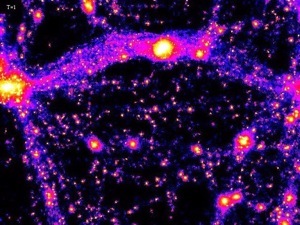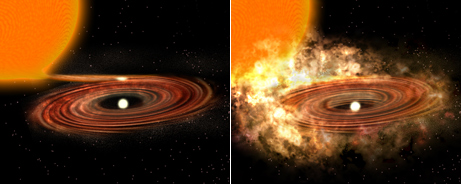Black Holes
The Holley-Bockelmann group is leading VIDA's efforts in studying galaxy dynamics, N-body simulations, supermassive black holes, and gravitational waves.
|
Simulations of Merging Black Holes With Miroslav Micic and Steinn Sigurdsson, we used this 10 million particle simulation of a 10 Mpc3-sized volume of the universe to study the merger rates of supermassive black holes from redshift 20 to today. Click on the image above for a movie. Our work makes heavy use of Vanderbilt's high-performance computing cluster, ACCRE. |
When black holes merge, they emit huge amounts of gravitational radiation—and if the merger is not symmetric (say the spins are mis-aligned, or the masses are different), these gravitational waves are emitted in a preferred direction. This sends the new black hole careening off with a recoil velocity that can be up to 9 million miles per hour! Such rapidly moving black holes will easily escape low mass systems like globular clusters. With Kayhan Gultekin, Nico Yunes, and Deirdre Shoemaker, we’re studying how well globular clusters can retain Intermediate Mass Black Holes against an onslaught of black hole mergers.
Holley-Bockelmann's research featured in National Geographic. A pair of artist's conceptions shows the disk of material around the binary star system WZ Sge, which consists of a white dwarf pulling material from a cooler companion. According to a previous model (left), the disk contained only visible material. But new findings suggest the presence of an asymmetric outer disk of dark matter (right). The research is just one of several new findings presented at a meeting of the American Astronomical Society that are helping to unravel the mysteries of black holes. |

